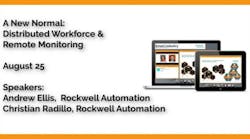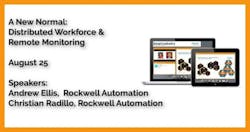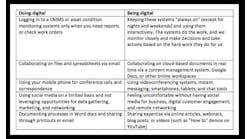How operators can capitalize on the new normal of distributed workforces & remote monitoring
Next week we connect with experts from Rockwell Automation and PTC for the Smart Industry webinar “A New Normal: Distributed Workforce & Remote Monitoring.”
Today we get a preview of that presentation from Val Laolagi, PTC principal engineer, who explores the opportunities in the “new normal,” trending applications of augmented reality and the modern toolbox of digital tools that enable unprecedented capabilities in the factory and the field.
Take a look…
Smart Industry: What is the "new normal"?
Val: The new normal has been significantly defined by new rules of social distancing—isolating customers from direct vendor or service support. Remote access, monitoring and service repair are more widely used now (at this stage of the pandemic) more than ever. Virtual workshops via video conferencing have grown immensely during these challenging times. Our tools enhance this distal learning by extending reality to include graphical, textual and model overlays—enhancing the user experience in this new remote environment by providing 3D work instructions, augmented reality (AR) instruction guides, and more effective communication and collaboration over standard worldwide devices.
Smart Industry: How is the pandemic changing distributed workforces and remote monitoring?
Val: Our applications/tools are directly aligned with an ever-increasing paradigm shift to a remote monitoring and supported landscape, just as there are tools for remotely connecting assets on the manufacturing floor or out in the field, or tools that enable experts to assist operators with an “over the shoulder” perspective of what the operator experiences as they work. We have tools that enable users to create powerful step-by-step AR instruction guides to help frontline workers get their jobs done quickly and accurately.
Smart Industry: Provide an example of augmented reality proving particularly effective in supporting digital manufacturing.
Val: Applying techniques to extend reality, such as AR, assisted reality, and mixed reality allows operators and service technicians (for example, in the manufacturing space) to virtually see what cannot be seen by the naked eye. For instance, showing a safety barrier that depicts the proximal distance a user should stand when operating an asset, or graphical indicators that direct users with an appropriate path for approaching an asset for inspection or repair. AR experiences make it easy to scale expert knowledge across your organization for better skill-development and training that increases productivity, reduces waste and scrap, and improves safety and compliance.



